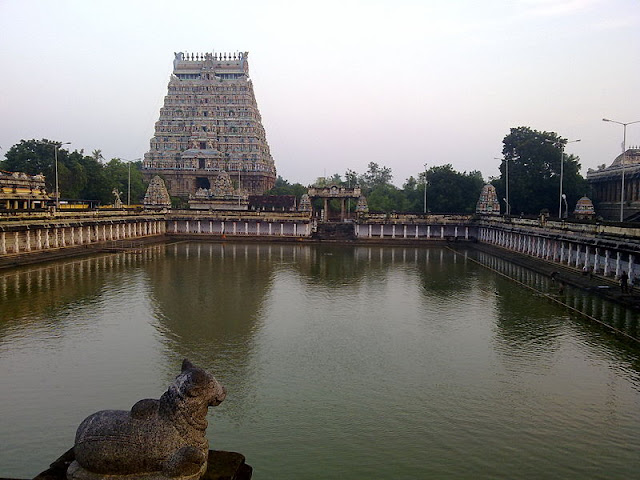Nataraja Temple, Chidambaram – Towers (Gopurams)
The temple has nine major gopuram gateways connecting
the various courtyards. Four of these are huge and colorful, visible from afar,
a symbolic and convenient landmark for pilgrims. The temple has 9 gateways and
four of these have towering pagodas or gopurams each with 7 levels in the East,
South, West and North. The first edition of the four gopuram superstructures
were likely built between 1150 and 1300 CE. The earliest was likely the western
gopuram, which is also the smaller of the four. This is generally dated to
about 1150 CE. The eastern gopura was likely completed by about 1200 CE,
southern gopura by mid-13th century, while the northern was added in
late 13th century.
The four high gopurams were destroyed, rebuilt,
repaired, enlarged and redecorated several times after the 13th century. This
has made the gopurams difficult to place chronologically, yet useful in
scholarly studies of the history of the Nataraja temple. All gopuras are built
of precisely cut large stone blocks all the way to the main cornice. Upon this
is a stone, brick and plaster structure with layers of pavilions. Above these talas
(storeys) is a Dravidian style barrel vaulted roof, crowned with thirteen kalasa finials.
All four are approximately similar in size and 14:10:3 ratio, about 42.7 metres
(140 ft.) high, 30.5 metres (100 ft.) wide and 9.1 metres (30 ft.)
deep.
There are no representations of Nataraja on the temple
towers, as this image is reserved for the innermost shrine alone. The inside
walls of passages through all the four gopurams are decorated with the 108 Karanas,
the dance movements of Shiva, from the Natya Shastra, the world's most ancient
treatise on dance, drama and theatre. Besides in Chidambaram these Karanas are
depicted in only four other temples, all in Tamil Nadu. The four gopurams,
together with the golden dome of the central shrine are the five towers which
represent the five faces of Shiva, with the Cit Sabha symbolizing the masterful
face.
Each gopuram is colorful and unique in its own ways.
They narrate stories from various Hindu texts, showing religious and secular
scenes from the various Hindu traditions. This art is presented in each gopuram
with anthropomorphic figure panels and about fifty niches with stone sculptures
in every gopuram. The scenes include multiple panels about the legend of
Shiva-Parvati wedding with Brahma, Vishnu, Saraswathi and Lakshmi attending,
dancing Ganesha, Shiva in his various aspects, Durga in the middle of her war
with a demon, Skanda ready for war, seated Nandi, musicians, dancers, farmers,
merchants, sadhu in namaste posture, dancing Dvarapalas near the vertical
center line and others. The artists and architects who built these gopura may
have had a rationale in the relative sequence and position of the artwork with
respect to each other and on various levels, but this is unclear and a subject
of disagreement among scholars.
Western
Gopuram:
The earliest and smallest of the four is
West gopuram constructed around 1150 and there is no reliable
evidence on the construction. The earliest built western gopuram is the
only one with inscriptions below each artwork that identifies what it is. The
artwork on it includes Durga fighting the evil, shape shifting buffalo demon
and Skanda sitting on peacock and dressed up for war. Other artwork found
on the eastern gopuram include Surya, Ganapati, Vishnu, Sridevi (Lakshmi),
Tripurasundari, Brahma, Saraswathi, Varuna, Durga, Agni, several rishis, Yamuna goddess, Kama and Rati, Budha, the Vedic sages
such as Narada and Agastya, Patanjali, Somaskanda legend, Ardhanarishvara (half
Shiva, half Parvati), Harihara (half Vishnu, half Shiva), several forms of
dancing Shiva and others.
Southern
Gopuram:
The South gopuram is called as Sokkaseeyan
Thirunilai Ezhugopuram was constructed by
a Pandya king identified from the presence of the dynasty's fish
emblem sculpted on the ceiling. The Pandyas sculpted two fishes facing each
other when they completed gopurams (and left it with one fish, in
case it was incomplete). Other artwork found on the southern gopuram include
Chandesha, Ganapati, Vishnu, Sridevi (Lakshmi), several Devis, Brahma, Saraswathi,
Surya, Chandra, Durga, Indra, Agni, several rishis, Ganga and Yamuna goddesses, Kama and Rati, Budha, the
Vedic sages such as Narada, Patanjali, Somaskanda legend, Ardhanarishvara (half
Shiva, half Parvati), Harihara (half Vishnu, half Shiva), several forms of
dancing and standing Shiva such as Pashupata, Kiratarjuna and Lingobhava, as
well as others.
Eastern
Gopuram:
The eastern gopuram features the 108 reliefs of Natya
Shastra dance postures (22 cm each in a separate niche) and faces the
sanctum. The eastern gopuram is credited to king Kopperunjingan II
(1243-1279 A.D.). As per epigraphical records and was repaired by
Subbammal, the mother-in-law of the famous philanthropist Pachaiappa
Mudaliar (1754-1794 A.D.). The idols of Pachaiappa Mudaliar and his wife
Iyalammal have been sculpted on the eastern gopuram. The Pachaiappa Trust
to date has been responsible for various functions in the temple and also maintains
the temple car. The eastern gopuram is renowned for its complete enumeration of
108 poses of Indian classical dance – Bharathanatyam, detailed in small rectangular panels along the passage
that leads to the gateway.
Northern
Gopuram:
The North Gopuram was initiated around 1300
A.D. with the brick portion constructed by
the Vijayanagara king Krishnadevaraya (1509-1530 A.D.) in
the 16th century. The eastern and northern gopura also depicts
the wide range of narratives as the southern and western gopuram.








